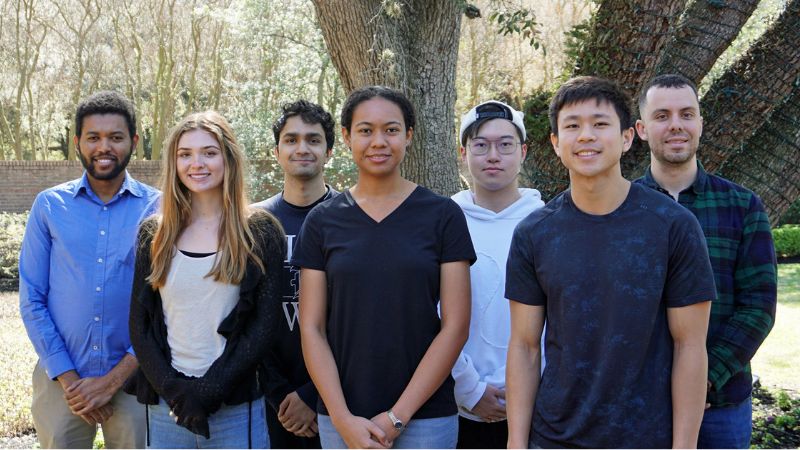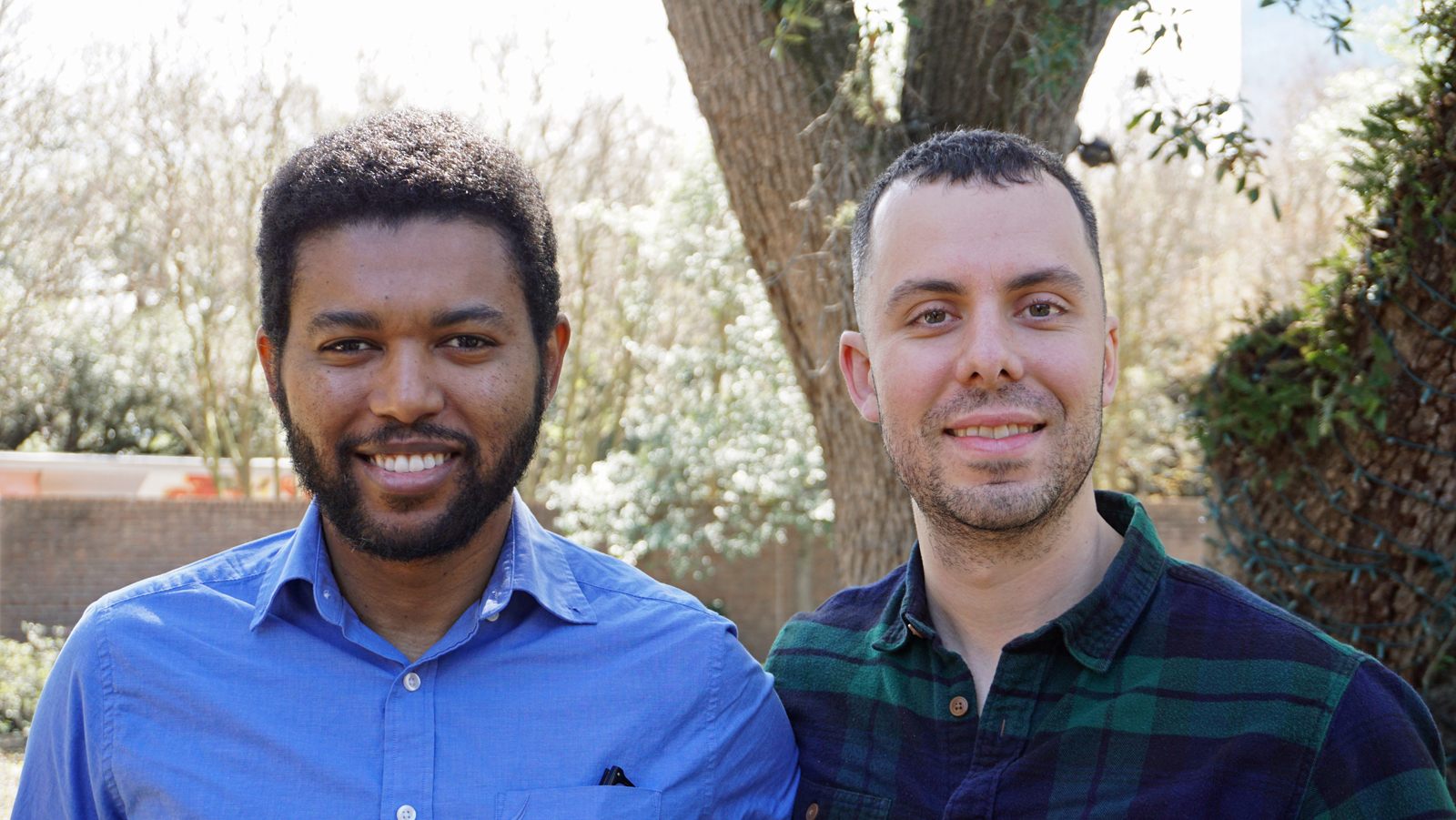Photo: Rice University Computer Science and Civil and Environmental Engineering faculty members Arlei Silva and James Doss-Gollin lead new U.S.-Brazil collaboration.
Rice University engineering students and their peers in two Brazilian universities are researching computational methods to address flooding and other climate-related crises, thanks to funding from the 100,000 Strong in the Americas initiative.
Led by assistant professors Arlei Silva in Computer Science and James Doss-Gollin in Civil and Environmental Engineering, the program integrates research and development, education, and local partnerships to improve infrastructure systems to better handle hydroclimate extremes.
“Like Houstonians, I grew up understanding the impact of extreme hydroclimate surges on our local roads, power, water, and other infrastructures in southern Brazil. As a Ph.D. student and postdoc in California, I became interested in the use of data to help solve climate challenges, particularly in regard to the infrastructure that is so necessary in times of disaster. When I was interviewing for a faculty role at Rice, that slide caught a lot of attention,” said Silva.
“One of the faculty members in the audience talked about Hurricane Rita and gave me examples of infrastructure and disaster preparedness, saying how relevant my interest was for Houston. He said, ‘Rice wants to play a local role and solve problems that we really care about here in Houston.’ That led to my collaboration with James, and ironically tied back to my own roots in Brazil. Climate change and weather-related disasters are a universal challenge right now, so the 100,000 Strong funding we received can help research teams in Brazil and Houston learn how to apply artificial intelligence (AI) methods in improving urban sustainability and resilience in natural disasters.”
Adapting existing behaviors, infrastructure, and resources to address the issues that arise with evolving climate change is of particular interest to Doss-Gollin. His research training is at the intersection of hydroclimate science, statistical and machine learning methods, and decision analysis — which he said helps him better understand specific AI methods and how they can be applied to solve critical adaption challenges.
He said, “Quantifying the risks of hydroclimate extremes in a changing climate involves weaving together three separate threads: (1) exploring a large number of possible climate futures, (2) representing the impact of each at the scale of rivers, buildings, and infrastructure systems, and (3) quantifying how these impacts affect vulnerable communities and ecosystems.
“Identifying promising strategies for mitigating these risks requires repeating this analysis for each strategy considered. Yet linking models that represent global-scale processes (e.g., global climate and weather patterns) to decision-relevant local variables (e.g., where flooding occurs in a city) remains a challenge. Physics-informed AI offers an opportunity to reduce the computational burden of these models while increasing their explainability.”
While Doss-Gollin and Silva were exploring their own research opportunities, Adria Baker in the Office of International Students and Scholars (OISS) learned of a new funding competition linking climate research with undergraduate research to be shared by universities in Brazil and the United States.
Baker, the Executive Director for the OISS and Rice’s Associate Vice Provost for International Education, has served on review panels for previous 100K Strong funding competitions. She had been impressed with the manner in which the foundation places strong value on follow-up assessment, multiplier-effect, binational mobility, and distinctive academic and global learning.
“I have known about the great impact this program has had through the years between U.S. universities and colleges and those throughout Latin America,” said Baker. “Many students who would never have conceived that they would be able to study or conduct research abroad, have the opportunity through the 100,000 Strong in the Americas. Their lives have been beautifully enhanced forever.”
Baker reached out to Silva, Marjorie Cerejo Esch — an OISS international delegate and compliance specialist who grew up in Brazil — and Fabiana Santos of Brasil@Rice to gauge interest in the funding proposal. Silva was willing to work up a proposal but did not have a contact at SENAI, a primary collaborator in the funding competition. Esch agreed to help identify potential faculty partners in SENAI and other institutions in northwest Brazil while Silva and Doss-Gollin began outlining a program that could provide undergraduate student research opportunities at Rice and connect their students with similar research teams in Brazil.
Silva said, “Marjorie helped us connect with Jose Wally Mendonça Menezes and Francisco Gutenberg Albuquerque Filho at Instituto Federal de Educação, Ciência e Tecnologia do Ceará (IFCE). Everyone was excited by the opportunity to further our research while providing an exchange of ideas and projects between our students and institutions.
“Our proposal was selected for funding and we began working toward our goal: to train a new generation of students in Brazil and the U.S. — in partnership with local stakeholders — to use artificial intelligence with infrastructure, climate, and urban data so we can address challenges caused by extreme weather.”
Silva’s area of interest is in the use of graphs to connect objects in complex systems. The models used to process large streams of infrastructure and climate-related data require more and more computing resources, but that demand can be streamlined by shifting to powerful models like graphs.
“That is how my original collaboration with James came about,” said Silva. “We were looking at modeling flooding in Houston and explored ways to better use computation to speed up that modeling. Could we use graphs as a way to do that?
“I really enjoy finding ways to apply tools from computer science to problems in different domains. It is very interesting to me to learn how people in that domain are approaching the problem, then look at it from a CS perspective. To that end, this new project is a great opportunity to get computer science students excited about solving climate and infrastructure problems.”
Silva used a selection process to find five Rice CS students interested in applying computational tools to climate-related infrastructure issues in Houston. In addition to the skills the students had previously acquired, they are now learning to use AI and other modeling tools to answer questions about sustainability and resilience to natural disasters in Houston and in the Americas.
“My expectation is that this collaboration between our students and those at SENAI and IFCE will lead to the development of new AI and big data software tools, which will then prompt innovations in technology as well as sectors like construction, engineering, and transportation infrastructure as we help develop designs for more resilient and sustainable infrastructure,” he said.

But Silva is also realistic about starting small. He said the first goal of the IFCE-Rice-SENAI program is to educate students about the research process. Undergraduate students may be more accustomed to projects with a finite closure, such as problems that can be solved by the end of a semester. Research does not adhere to that kind of timeline and Silva said their students’ first attempts will probably fail.
“These are very hard problems, but the faculty members at Rice, IFCE, and SENAI want our students to see that big problems are worth solving, worth the effort, worth the frustration of failing and trying again. Maybe they will even be inspired to pursue their research as a career effort, but primarily we want them to focus on solving real life problems as we help them learn and navigate the research process,” said Silva.
“Part of that learning is setting goals and evaluating progress and results the way researchers do. In the Rice students’ case, how accurate are our models? Can they predict major flooding events in Houston? If we’d had their ‘new’ modeling tools at the time of say, Hurricane Rita, could we have helped mitigate the damage?”
Doss-Gollin is pleased with the results of the Rice team thus far. He said, “We’ve turned a small team of undergraduate students loose on a set of interesting problems and provided them with some overview trainings and projects. Their enthusiasm for the material and the unique skill sets and experience that each brings to bear is inspiring. I'm excited to see what they can discover and solve in this first phase.
His status update makes Esch smile; when she agreed to assist with the early stages of the proposal, she anticipated great outcomes of the binational collaboration. She said, “This program provides an opportunity for students to learn about AI technologies and apply them to real-world problems related to urban sustainability and resilience.”
“It also allows institutions to access [each other’s] cutting-edge research and develop innovative solutions that could help them better prepare for natural disasters. This kind of collaboration is mutually beneficial as it helps both parties gain knowledge, skills, and resources that they wouldn't have had access to otherwise.”
Doss-Gollin is proud of the way the program has brought together stakeholders with different timelines and pressures to develop shared curricula around urban resilience and AI. “This allows us to not only increase the quality and relevance of these materials, but also to make them accessible to problem-solvers around the world. Solving these challenging and important questions requires global collaboration, and based on this experience and my prior research collaborations in Brazil, I am thankful to learn from and share insights with our international colleagues,” he said.
Baker was confident the collaboration would be a success. She said, “Anytime you can engage students from the USA to travel to Brazil, or Brazilians to come to the USA, you are going to find that there are so many great things they can learn from each other – personally and academically,” she said.
“I believe the topics that the faculty members and collaborators are developing will be extremely beneficial to both countries. We all have so much to learn with this topic, and the student interactions with one another and the faculty members will be priceless.”
This type of collaboration is one of the reasons Silva was first drawn to Rice. He said, “Rice has a global perspective and is very intentional about connecting with other institutions as an international university — all over the world, but especially in South America. Rice is also known for its undergraduate research opportunities. Many top tier universities offer great courses and instructors, but the opportunity to engage in research outside the classroom, and to do so in an international collaboration is unusual. Except at Rice.”
Silva is also thankful for the support key members of the Rice community provided for this particular project. In addition to Baker’s endorsement, the proposal received letters of support from Lydia Kavraki, Angela Wilkins, Luay Nakhleh, and Phillip Bedient.
Bedient is the Herman Brown Professor of Engineering in the Department of Civil and Environmental Engineering and may be best known for his hydrology and flood prediction research in the SSPEED Center. Kavraki’s letter of support was linked to her role as the Director of the Ken Kennedy Institute, but she is also the Noah Harding Professor of Computer Science, professor of Bioengineering, professor of Electrical and Computer Engineering, and professor of Mechanical Engineering at Rice. Wilkins is the executive director of the Ken Kennedy Institute. Nakhleh is the William and Stephanie Sick Dean of the George R. Brown School of Engineering, but he is also the former chair of the Computer Science Department and remains a professor of CS and of BioSciences.
Silva said, “Next, we will organize a workshop here at Rice to bring together students from Rice, IFCE, and SENAI, community partners, and Rice researchers working at the intersection of AI, resilient infrastructure and sustainability. We are very thankful for all the support we have received for this project and are very excited about the impact it will have in all the institutions involved.”

